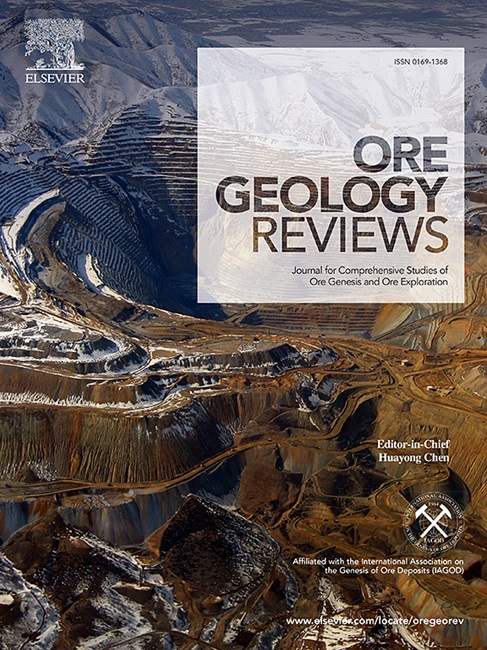闪辉石的成因及其对稀土元素成矿的意义——来自华北克拉通龙宝山矿床的启示
IF 3.6
2区 地球科学
Q1 GEOLOGY
引用次数: 0
摘要
闪辉岩常与临界金属成矿作用有关;但其成因仍有争议,在稀土成矿中的意义尚不清楚。龙宝山闪辉岩具有明显的稀土矿化特征。对中国鲁西地块龙宝山矿床的闪辉石稀土矿体进行了矿物学、形态和矿物地球化学分析。采用微x射线荧光光谱(μ-XRF)元素测图结合ImageJ图像分析对闪辉石的矿化进行了评价。结果表明,该闪辉岩经历了3期热液交代作用,均导致其稀土元素富集。-Ⅰ交代阶段形成闪辉石,其间形成辉云母(~ 80%)和闪辉矿(1 - 2%体积)晶体。钛矿被切钾矿(Ce)取代并包裹,表明后者为交代成因。因为绿云母和菱铁矿-(Ce)晶体彼此具有平衡接触,表明它们共同的交代起源。与未蚀变的绿云母周围的蚀变晕相比,未蚀变的绿云母的Fe/Mg值较低,Na、Ba和Sr浓度较高,也支持了这一点。该蚀变晕被解释为ii期交代作用的蚀变,本质上是硅质蚀变,在辉云母中加入Si和F,形成石英脉和萤光闪辉石-(Ce),分别占闪辉石的15%和24%。氟磷灰石-(Ce)晶体是通过取代闪辉石中的氟磷灰石而形成的。卤素逸度在ii期交代过程中低于闪辉石形成过程,且F逸度的下降速度快于Cl逸度的下降速度。我们由此得出结论,驱动稀土矿物沉淀的主要因素是F相对于Cl逸度的显著降低。第三阶段交代作用是由碳酸盐流体引起的,碳酸盐流体将萤石-(Ce)蚀变为parisite-(Ce)和synchysite-(Ce)的集合体(这两者共占闪辉石体积的29%)。质量平衡计算表明,第二阶段硅质交代作用使闪辉岩中稀土元素的富集程度是初始矿物学阶段的15倍,而碳酸盐流体交代作用(第三阶段)对稀土元素富集的贡献很小。本文章由计算机程序翻译,如有差异,请以英文原文为准。

The origin of glimmerite and its significance to rare earth element mineralization: Insights from the Longbaoshan deposit in North China Craton
Glimmerite is often associated with critical metal mineralization; however, its origin remains controversial, and the significance of glimmerite in rare earth mineralization is unclear. At Longbaoshan, glimmerite exhibits significant rare earth mineralization. We conducted mineralogical, morphological, and mineral geochemical analysis on the glimmerite REE orebodies in the Longbaoshan deposit in the Luxi Block of China. Micro X-Ray Fluorescence Spectrometry (μ-XRF) elemental mapping combined with an ImageJ image analysis was used to evaluate the mineralization of the glimmerite. We identified that the glimmerite experienced three stages of hydrothermal metasomatism, all of which led to REE enrichment in the glimmerite. The stage-Ⅰ metasomatism formed the glimmerite, during which phlogopite (∼80 %) and chevkinite-(Ce) crystals (1–2 % in volume) were formed. Titanite was replaced and enclosed by chevkinite-(Ce), suggesting a metasomatic origin of the latter. Because the phlogopite and chevkinite-(Ce) crystals share equilibrium contacts with each other, indicating their common, metasomatic origin. This is also supported by the lower Fe/Mg value and higher concentrations of Na, Ba, and Sr of unaltered phlogopite compared to the alteration halos surrounding unaltered phlogopite. This alteration halo is interpreted as alteration by a stage-II metasomatism, which is, in nature, a siliceous alteration that added Si and F in phlogopite and formed quartz veins and fluorbritholite-(Ce) which occupied 15 vol% and 24 vol% of glimmerite, respectively. The fluorbritholite-(Ce) crystals are formed through the replacement of fluorapatite in the glimmerite. The halogen fugacity during stage-II metasomatism is lower than that during the formation of glimmerite, with the rate of decrease in F fugacity faster than that of Cl fugacity. We use this to conclude that the primary factor driving the precipitation of rare earth minerals is the dominant decrease of F relative to Cl fugacity. The stage-III metasomatism was brought about by a carbonate fluid that altered fluorbritholite-(Ce) into aggregates of parisite-(Ce) and synchysite-(Ce) (these two together occupy 29 % of the volume of glimmerite). Mass balance calculations reveal that the second stage of siliceous metasomatism resulted in 15 times of REE enrichment in the glimmerite compared to the initial mineralogy of glimmerite, while the contribution of carbonate fluid metasomatism (Stage III) to REE enrichment was minimal.
求助全文
通过发布文献求助,成功后即可免费获取论文全文。
去求助
来源期刊

Ore Geology Reviews
地学-地质学
CiteScore
6.50
自引率
27.30%
发文量
546
审稿时长
22.9 weeks
期刊介绍:
Ore Geology Reviews aims to familiarize all earth scientists with recent advances in a number of interconnected disciplines related to the study of, and search for, ore deposits. The reviews range from brief to longer contributions, but the journal preferentially publishes manuscripts that fill the niche between the commonly shorter journal articles and the comprehensive book coverages, and thus has a special appeal to many authors and readers.
 求助内容:
求助内容: 应助结果提醒方式:
应助结果提醒方式:


